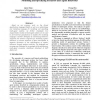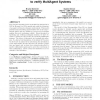84 search results - page 1 / 17 » Modelling and Specifying Scenarios and Agent Behaviour |
IAT
2003
IEEE
13 years 10 months ago
2003
IEEE
Based on our previous work on the formal specification language SLABS as well as a methodology and modelling language for modelling and specifying multi-agent systems, we further ...
SEKE
2005
Springer
13 years 10 months ago
2005
Springer
Abstract. Emergent behaviour (EB) is a common phenomenon in multi-agent systems (MAS) where autonomous agents perform certain actions with only limited access to local information ...
IAT
2008
IEEE
13 years 11 months ago
2008
IEEE
From an external perspective, cognitive agent behaviour can be described by specifying (temporal) correlations of a certain complexity between stimuli (input states) and (re)actio...
JOT
2010
13 years 3 months ago
2010
To achieve the multi-agent systems’ goals, agents interact to exchange information, to cooperate and to coordinate their tasks. Interaction is generally recognized as an importa...
ATAL
2009
Springer
13 years 9 months ago
2009
Springer
The Goal Decomposition Tree model has been introduced in 2005 by Mermet et al. [9] to specify and verify the behaviour of an agent evolving in a dynamic environment. This model pr...


